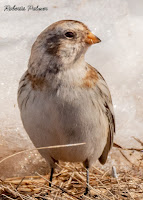SNOW BUNTING
SNOW BUNTING – (Plectrophenax nivalis) – (See images below)
DESCRIPTION: The Snow bunting is a passerine bird. The breeding male is mostly white in the summer, with black back and wing tips. The small conical bill and eyes are black, and the legs and feet dark grey. Breeding females have a mottled brown back and a grey head, as well as grey under parts. Its bill and legs are brown. In the winter the male has a rufous cap, an orange bill and a rufous patch on the neck behind the eye. The back has dark streaks. Non-breeding females have more rufous plumage on the head, neck, breast and upper back and upper wings. Its bill is orange. This bird is around 15 cm (6 inches) long.
VOICE: https://www.xeno-canto.org/species/Plectrophenax-nivalis – The flocks also vocalize in flight, as can be assumed from one of the photos below, where several birds have their bills open.
NAME: The English name ‘Bunting’ has an unknown origin. The Latin genus name ‘Plectrophenax’ is from Greek and means ‘cock’s spur’ and ‘imposter’, and the Latin species name ‘nivalis’ means ‘snow’.
HABITAT: Tundra in the summer, fields, roadsides and coastal areas in the winter.
DIET: Plant seeds and invertebrates in the summer, weed seeds in the winter.
NESTING: Snow buntings make their nests in cavities, either natural or on buildings. The nest is lined with down and feathers as insulation from the cold, and the female stays on it to protect the chicks from the cold. She is then fed by the male. Around four to six creamy eggs are laid, which are incubated by the female. Both parents feed the chicks.
DISTRIBUTION: The snow bunting breeds in the Arctic around the world and spends the winter south of that region. Some vagrants have been able to reach Hawaii. (See note below on bird vagrancy.)
DISTRIBUTION MAP: https://en.wikipedia.org/wiki/Snow_bunting#/media/File:Plectrophenax_nivalis_map.svg
ON PEI: The snow bunting is observed in the winter on Prince Edward Island. It is then very common in the fields, where it forms large flocks.
CONSERVATION: With the Arctic warming up sooner in the spring due to climate change, snow buntings tend to return to their breeding areas earlier, thus creating a mismatch between the timing of their arrival and the timing of their food sources.
NOTES: The snow bunting is also called ‘Snowflake’ due to its flying patterns in the fields in the winter. This passerine has the most northerly range of its order.
Vagrancy: In biology this means an animal going way outside its normal range. For birds, this can happen when there are storms and they get blown off course. On other times, the bird simply wanders in a different direction than usual. Here’s an article about vagrancy in birds.
SIMILAR SPECIES: Lapland Longspur, Horned Lark
REFERENCES: https://www.allaboutbirds.org/guide/Snow_Bunting/id
http://www.npolar.no/en/species/snow-bunting.html (Norwegian Polar Institute)
http://www.oiseaux-birds.com/card-snow-bunting.html
https://www.audubon.org/field-guide/bird/snow-bunting
https://en.wikipedia.org/wiki/Snow_bunting
DESCRIPTION: The Snow bunting is a passerine bird. The breeding male is mostly white in the summer, with black back and wing tips. The small conical bill and eyes are black, and the legs and feet dark grey. Breeding females have a mottled brown back and a grey head, as well as grey under parts. Its bill and legs are brown. In the winter the male has a rufous cap, an orange bill and a rufous patch on the neck behind the eye. The back has dark streaks. Non-breeding females have more rufous plumage on the head, neck, breast and upper back and upper wings. Its bill is orange. This bird is around 15 cm (6 inches) long.
VOICE: https://www.xeno-canto.org/species/Plectrophenax-nivalis – The flocks also vocalize in flight, as can be assumed from one of the photos below, where several birds have their bills open.
NAME: The English name ‘Bunting’ has an unknown origin. The Latin genus name ‘Plectrophenax’ is from Greek and means ‘cock’s spur’ and ‘imposter’, and the Latin species name ‘nivalis’ means ‘snow’.
HABITAT: Tundra in the summer, fields, roadsides and coastal areas in the winter.
DIET: Plant seeds and invertebrates in the summer, weed seeds in the winter.
NESTING: Snow buntings make their nests in cavities, either natural or on buildings. The nest is lined with down and feathers as insulation from the cold, and the female stays on it to protect the chicks from the cold. She is then fed by the male. Around four to six creamy eggs are laid, which are incubated by the female. Both parents feed the chicks.
DISTRIBUTION: The snow bunting breeds in the Arctic around the world and spends the winter south of that region. Some vagrants have been able to reach Hawaii. (See note below on bird vagrancy.)
DISTRIBUTION MAP: https://en.wikipedia.org/wiki/Snow_bunting#/media/File:Plectrophenax_nivalis_map.svg
ON PEI: The snow bunting is observed in the winter on Prince Edward Island. It is then very common in the fields, where it forms large flocks.
CONSERVATION: With the Arctic warming up sooner in the spring due to climate change, snow buntings tend to return to their breeding areas earlier, thus creating a mismatch between the timing of their arrival and the timing of their food sources.
NOTES: The snow bunting is also called ‘Snowflake’ due to its flying patterns in the fields in the winter. This passerine has the most northerly range of its order.
Vagrancy: In biology this means an animal going way outside its normal range. For birds, this can happen when there are storms and they get blown off course. On other times, the bird simply wanders in a different direction than usual. Here’s an article about vagrancy in birds.
SIMILAR SPECIES: Lapland Longspur, Horned Lark
REFERENCES: https://www.allaboutbirds.org/guide/Snow_Bunting/id
http://www.npolar.no/en/species/snow-bunting.html (Norwegian Polar Institute)
http://www.oiseaux-birds.com/card-snow-bunting.html
https://www.audubon.org/field-guide/bird/snow-bunting
https://en.wikipedia.org/wiki/Snow_bunting
 |
| Snow buntings, PEI, Matt Beardsley |
 |
| Snow buntings, PEI, Matt Beardsley |
 |
| Snow bunting, PEI, by Roberta Palmer |
 |
| Snow bunting, PEI, Roberta Palmer |